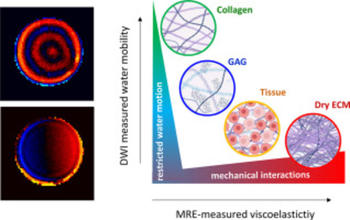On the relationship between viscoelasticity and water diffusion in soft biological tissues
Braun, J.; Bernarding, J.; Snellings, J., Meyer, T.; Dantas de Moraes, P.A.; Safraou, Y., Wells, R.G.; Guo, J.; Tzschätzsch, H., Zappe, A.; Pagel, K.; Sauer, I.M.; Hillebrandt, K.H.; Sack, I.* – 2024
Magnetic resonance elastography (MRE) and diffusion-weighted imaging (DWI) are complementary imaging techniques that detect disease based on viscoelasticity and water mobility, respectively. However, the relationship between viscoelasticity and water diffusion is still poorly understood, hindering the clinical translation of combined DWI-MRE markers. We used DWI-MRE to study 129 biomaterial samples including native and cross-linked collagen, glycosaminoglycans (GAGs) with different sulfation levels, and decellularized specimens of pancreas and liver, all with different proportions of solid tissue, or solid fractions. We developed a theoretical framework of the relationship between mechanical loss and tissue-water mobility based on two parameters, solid and fluid viscosity. These parameters revealed distinct DWI-MRE property clusters characterizing weak, moderate, and strong water-network interactions. Sparse networks interacting weakly with water, such as collagen or diluted decellularized tissue, resulted in marginal changes in water diffusion over increasing solid viscosity. In contrast, dense networks with larger solid fractions exhibited both free and hindered water diffusion depending on the polarity of the solid components. For example, polar and highly sulfated GAGs as well as native soft tissues hindered water diffusion despite relatively low solid viscosity. Our results suggest that two fundamental properties of tissue networks, solid fraction and network polarity, critically influence solid and fluid viscosity in biological tissues. Since clinical DWI and MRE are sensitive to these viscosity parameters, the framework we present here can be used to detect tissue remodeling and architectural changes in the setting of diagnostic imaging.
Magnetic resonance elastography (MRE) and diffusion-weighted imaging (DWI) are complementary imaging techniques that detect disease based on viscoelasticity and water mobility, respectively. However, the relationship between viscoelasticity and water diffusion is still poorly understood, hindering the clinical translation of combined DWI-MRE markers.
We used DWI-MRE to study 129 biomaterial samples including native and cross-linked collagen, glycosaminoglycans (GAGs) with different sulfation levels, and decellularized specimens of pancreas and liver, all with different proportions of solid tissue, or solid fractions. We developed a theoretical framework of the relationship between mechanical loss and tissue-water mobility based on two parameters, solid and fluid viscosity. These parameters revealed distinct DWI-MRE property clusters characterizing weak, moderate, and strong water-network interactions. Sparse networks interacting weakly with water, such as collagen or diluted decellularized tissue, resulted in marginal changes in water diffusion over increasing solid viscosity. In contrast, dense networks with larger solid fractions exhibited both free and hindered water diffusion depending on the polarity of the solid components. For example, polar and highly sulfated GAGs as well as native soft tissues hindered water diffusion despite relatively low solid viscosity.
Our results suggest that two fundamental properties of tissue networks, solid fraction and network polarity, critically influence solid and fluid viscosity in biological tissues. Since clinical DWI and MRE are sensitive to these viscosity parameters, the framework we present here can be used to detect tissue remodeling and architectural changes in the setting of diagnostic imaging.





